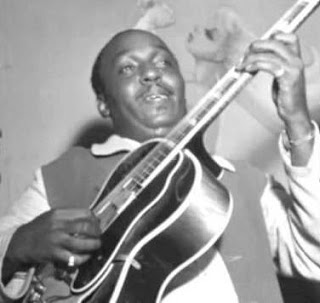Albert Aloysius Casey (September 15, 1915 – September 11, 2005) known professionally as Al Casey, was a jazz guitarist who was a member of Fats Waller's band during the 1930s and early 1940s. During his career, Casey worked with Louis Armstrong, Chu Berry, Coleman Hawkins, Lionel Hampton, Billie Holiday, Billy Kyle, Frankie Newton, Clarence Profit, Art Tatum, and Teddy Wilson.
Al Casey towers alongside the finest acoustic guitarists of the
swing era, boasting a subtly powerful presence that flourished in intimate musical contexts. Born in Louisville, Kentucky, Casey was a child prodigy who first adopted the violin, briefly moving to the ukulele before zeroing in on the guitar, which he studied at New York City's DeWitt Clinton High School. He joined Fats Waller while in his mid-teens, recommended to the legendary pianist by his uncles, who met Waller while on tour with their gospel group the Southern Singers.
swing era, boasting a subtly powerful presence that flourished in intimate musical contexts. Born in Louisville, Kentucky, Casey was a child prodigy who first adopted the violin, briefly moving to the ukulele before zeroing in on the guitar, which he studied at New York City's DeWitt Clinton High School. He joined Fats Waller while in his mid-teens, recommended to the legendary pianist by his uncles, who met Waller while on tour with their gospel group the Southern Singers.
Waller insisted Casey remain in school and earn his diploma before he could join the group full-time, but the guitarist was a fixture of recording sessions from the early '30s onward, and even joined Waller on tour during extended holiday breaks. Casey remained with the group until Waller's 1943 death, appearing on more than 200 classic swing sides; the famous blues number "Buck Jumpin'" took shape after Casey appeared late to a gig, prompting Waller to single him out on-stage and invite him to play a solo. The result was so electrifying that it was later captured in the studio.
Live recording, WNEW broadcast, NYC, May 31, 1947.
 Casey also recorded with trumpeter Louis Armstrong, singer Billie Holiday, vibist Lionel Hampton, and pianist Teddy Wilson, even joining the latter's short-lived big band in 1939. After Waller's passing, he played with pianist Clarence Profit's trio before assembling his own trio, which headlined New York's Onyx Club for close to a year before moving to the Down Beat. Around this time Casey moved to the electric guitar, and in both 1944 and 1945 he was named the instrument's top player in Esquire magazine's annual jazz poll; he spent much of the decade to follow as a gun-for-hire, capped off by a four-year collaboration with R&B saxophonist King Curtis initiated in 1957.
Casey also recorded with trumpeter Louis Armstrong, singer Billie Holiday, vibist Lionel Hampton, and pianist Teddy Wilson, even joining the latter's short-lived big band in 1939. After Waller's passing, he played with pianist Clarence Profit's trio before assembling his own trio, which headlined New York's Onyx Club for close to a year before moving to the Down Beat. Around this time Casey moved to the electric guitar, and in both 1944 and 1945 he was named the instrument's top player in Esquire magazine's annual jazz poll; he spent much of the decade to follow as a gun-for-hire, capped off by a four-year collaboration with R&B saxophonist King Curtis initiated in 1957.Casey briefly retired from music in 1961, working in a Xerox copy shop before returning to performing, recording sessions in support of singer Helen Humes and pianist Jay McShann. After another extended period of retirement, he resurfaced in 1981 with the Harlem Jazz and Blues Band, which toured the world with success until the middle Nineties. A small band drawn from the group and led by Casey was resident at the Louisianan Community Bar and Grill from 1992 to 1997. He also cut his first headlining date, signing to the Jazzpoint label for A Tribute to "Fats" in 1994.
After a long battle with colon cancer, Casey died at the Dewitt Rehabilitation Centre, Manhattan on September 11, 2005, just days short of his 90th birthday. He had been hospitalized for about a year.
(Edited mainly from All Music) (*There is some debate over Casey’s date of birth as a census record indicates he could have been born some time in 1917.) Also not to be confused with Al Casey, the session guitarist, rockabilly artist,& Duane Eddy collaborator.




